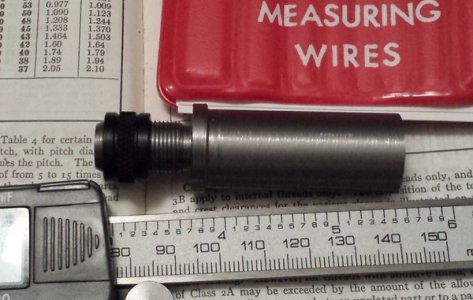- Joined
- Apr 12, 2013
- Messages
- 562
I don't know if runout is even the correct term. I'm trying to make a 1/2-28 tpi mandrel. I chucked up a piece of 1018 barstock and performed all operations to build the mandrel without loosening the chuck (3 jaw+dead center as required) so at this point everything should be as concentric and aligned as I can make it on my equipment. I actually made several, so I got better and better till I screwed something up (cut threads too deep, for example).
Rev 2 shown (with thread protector and 3 thou undersized threads), rev 3 lengthened center full diameter section for ease in centering with indicator and reduced drive shank to 1/2" for use with collet (eventually).

SO, as the last step I pull back the tailstock so I can part off the nub where the dead center was, and the cutoff blade hangs and stalls the lathe (to belt slippage, not locked in but these belts are grippy). It looked like there was a bit of wobble afterwards in the threads but after finishing the cut with a hacksaw, chucking the mandrel into a 4 jaw (no collets yet) and dialing in the shank I'm not so sure. I need to find a way to measure the threaded shank with my standard dial indicator.
I tried running the indicator over the tops of the threads and noting the highest and lowest values but I have low confidence in this. Given the large (relatively) radius of the nose on my indicator I don't see it reading the 28 TPI thread well.
Should I try lightly gluing a thread wire to the indicator tip? I don't have much budget for specialized measurement solutions. What else will allow me to accurately measure the runout at the threaded shank of this mandrel to check and see if the cutoff blade hanging has bent my mandrel?
Rev 2 shown (with thread protector and 3 thou undersized threads), rev 3 lengthened center full diameter section for ease in centering with indicator and reduced drive shank to 1/2" for use with collet (eventually).

SO, as the last step I pull back the tailstock so I can part off the nub where the dead center was, and the cutoff blade hangs and stalls the lathe (to belt slippage, not locked in but these belts are grippy). It looked like there was a bit of wobble afterwards in the threads but after finishing the cut with a hacksaw, chucking the mandrel into a 4 jaw (no collets yet) and dialing in the shank I'm not so sure. I need to find a way to measure the threaded shank with my standard dial indicator.
I tried running the indicator over the tops of the threads and noting the highest and lowest values but I have low confidence in this. Given the large (relatively) radius of the nose on my indicator I don't see it reading the 28 TPI thread well.
Should I try lightly gluing a thread wire to the indicator tip? I don't have much budget for specialized measurement solutions. What else will allow me to accurately measure the runout at the threaded shank of this mandrel to check and see if the cutoff blade hanging has bent my mandrel?
